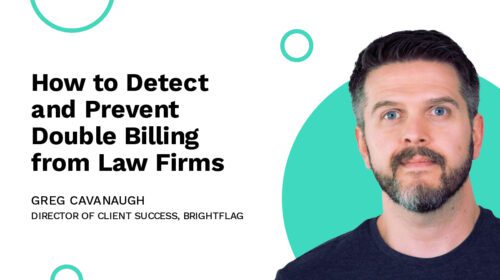You Don’t Need ABA Litigation Codes For Invoice Review (If You Have A.I.)
No in-house attorney wants to wrap up their week by staring at 23 pages of billed hours from a law firm. Yet, invoice review is central to controlling legal costs.
Decades ago, the American Bar Association (ABA) tried simplifying things by creating a long list of standardized billing codes to classify the legal services outside counsel perform.
But even with a billing code set, invoice review is tedious, error-prone, and doesn’t leave space for in-house legal teams to glean strategic insights.
Artificial Intelligence (A.I.) is the solution.
A.I. doesn’t get bored, tired, or distracted while scanning thousands of line items of information. It can consume an entire invoice and spit out trends, discrepancies, and insights in seconds.
A.I. doesn’t just make invoice review faster for in-house legal teams. It also cuts costs, improves accuracy, and reveals trends and patterns in legal spend.
What Are ABA Codes?
The American Bar Association (ABA) originally created ABA codes (also known as Uniform Task-Based Management System, or UTBMS codes) to make it easier to understand, categorize, and analyze the legal services a law firm performs.
They categorized those codes by matter types, phases, and activities.
For example, a code with the prefix B denotes a bankruptcy matter. The B100 series of codes are all part of the administration phase of the bankruptcy matter. Finally, you get to the individual activity. An attorney who spent the morning talking with creditors would code that work as B150 – communications with creditors.
ABA codes are put into a standardized format called Legal Electronic Data Exchange Standard (LEDES) files. LEDES makes it easy to send and receive invoices digitally.
Eliminate Errors In ABA Litigation Coding With A.I. Invoice Review
Outside counsel must enter their time into their law firm billing system and select the corresponding ABA code for each task they performed.
This typically happens at the end of a long day or—if things have been especially busy—a long week. They’re working on many matters simultaneously. Under those conditions, they might not spend much time thinking about which code a particular task should get. And, really, who can blame them? It’s also too easy to click the code above or below the intended selection.
Even if an attorney is careful, there are fuzzy distinctions between the codes for some legal services. For example, a line item on an invoice may read something like “deposed expert witnesses”. But both “L330 – Depositions” and “L420 – Expert Witnesses” could work equally well as codes.
This is inevitable in a code system that tries to cover every conceivable activity. Code interpretation by outside counsel is a major flaw in the ABA litigation code system.
That variability in interpretation leads to inconsistent data. If your data isn’t accurate, you can’t say with confidence which vendor deals with certain matter types most efficiently, for example. It’s difficult to parse what phases of a matter are eating the most budget, or gauge if a firm is charging too much of a matter to partner time.
The solution is to let outside counsel bypass coding their activities altogether. Instead, they just describe the work they’ve done (which, of course, they have to do anyway even if they code lines as well). Then, in-house teams can use A.I. for invoice review.
Just like ChatGPT can instantly read a whole novel and summarize the plot, A.I. can read thousands of invoice line items in an instant. It understands the work performed, then categorizes that work using the same ABA codes.
This is a better system than having outside counsel code, because it will code consistently across millions of line items of data inputted by thousands of attorneys at dozens of vendors. That means you can actually use that data to make decisions about your spend management.
Capture 100% Of Your ABA Litigation Code Data
Half of all invoices in the U.S. are submitted in PDF format. That figure jumps to nearly 90 percent internationally.
The problem with PDF invoice submissions is that most billing software can’t convert those invoices into a usable format. Since ABA codes can’t be read from PDFs, that invoice data will never be coded.
However, innovative technology can be used to overcome this challenge. Take Brightflag’s enterprise legal management solution, for example. Brightflag uses Optical Character Recognition (or OCR) to read PDF invoices and convert the information within PDFs into structured data.
OCR turns images, like a photo of a receipt or the PDF of an invoice, into text data. Brightflag combines OCR with A.I. to read PDFs and categorize them automatically based on ABA codes. That gives you the power to analyze your legal spend with a clear view of all your data.
Automate Spend Management
Budgets are getting tighter, but the work in-house teams need to do is only increasing. In this environment, efficiency and cost management are more crucial than ever.
A.I. invoice review is a first line of defense against non-compliant billing practices. It automatically scans each invoice line item and codes them using the ABA system.
From there, it can highlight any line items that contradict your outside counsel guidelines. This speeds up legal e-billing and decreases the number of errors and disputes between you and your vendors.
A.I.-powered spend management tools also identify trends and anomalies that might go unnoticed.
For instance, the system can identify when vendors bill too much time for internal communications or other administrative tasks. It can then automatically flag those potential violations for a human review. This helps ensure cost-effective outside counsel usage and provides valuable insights about vendor performance that legal ops can use during future engagements.
Free Time For Higher Value Work
Using A.I. to automate ABA coding is powerful because now you have a bank of consistent, coded data. That clean, high-quality data allows your team to confidently analyze things like:
- Costs by matter type
- Costs by matter phase
- Resourcing efficiency, i.e. the mix of hours worked by firm partners vs. firm associates for specific legal tasks
With A.I. handling much of the tedious parts of invoice review, your attorneys no longer have to spend time trawling through invoices to assess the work performed or find billing issues. Now, they’re freed up to do what they do best: provide legal advice to the business.
After all, A.I. is great at consuming vast pools of data and identifying trends. But the legal team is best positioned to decide what to do with that information.
As a bonus, your law firm partners will appreciate the convenience of not having to code their line items or answer questions from your team about miscoded lines. A.I. invoice review makes things faster and easier for them, too.
Move Beyond ABA Litigation Codes With Brightflag
Embrace a new era in legal spend management with Brightflag’s A.I.-powered invoice review. Brightflag uses project codes, but our technology moves beyond the reliance on inconsistent outside counsel coding.
Our A.I. doesn’t just read invoices; it understands them, turning data into actionable insights. This transition saves time and ensures comprehensive data capture, enabling better decision-making and a complete understanding of your legal expenditures.
With Brightflag, the focus shifts from tedious manual invoice review to strategic spend management. Our A.I. automates the review process, highlights deviations from set guidelines, and identifies trends, offering a clearer view of your legal operations. Learn more about our A.I. invoice review by booking a demo with Brightflag today.



